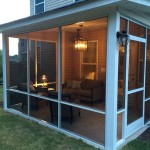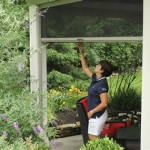Can You Replace Glass In A Patio Door?
Patio doors, often large expanses of glass that connect indoor living spaces with the outdoors, are a desirable feature in many homes. However, like any glass structure, patio door glass is susceptible to damage from impacts, weathering, or even spontaneous breakage. A common question that arises when a patio door's glass is damaged is whether the glass alone can be replaced, or if the entire door unit requires replacement.
The answer to this question is generally yes, the glass in a patio door can be replaced. However, the feasibility and cost-effectiveness depend on several factors, including the type of patio door, the extent of the damage, and the availability of replacement glass. Understanding these factors is crucial for making an informed decision about whether to replace the glass or the entire door.
This article will explore the various aspects of patio door glass replacement, providing insights into the types of glass used in patio doors, the process of replacement, the factors influencing the decision to replace glass versus the entire door, and considerations for cost and energy efficiency.
Types of Glass Used in Patio Doors
Patio doors utilize various types of glass, each offering different properties and advantages. The type of glass installed in the patio door will significantly influence the replacement process and cost. Here are some common types of glass found in patio doors:
Tempered Glass: Tempered glass is a safety glass that is heat-treated to make it much stronger than standard annealed glass. When tempered glass breaks, it shatters into small, relatively harmless pieces, reducing the risk of serious injury. This type of glass is often required by building codes for patio doors due to its safety characteristics. Replacement tempered glass needs to be custom-ordered to the exact dimensions of the original pane.
Laminated Glass: Laminated glass consists of two or more layers of glass bonded together with a plastic interlayer. This interlayer holds the glass fragments together if the glass breaks, preventing it from shattering and creating a significant safety hazard. Laminated glass also provides enhanced security and sound insulation. Like tempered glass, replacement laminated glass typically requires custom sizing.
Insulated Glass Units (IGUs): IGUs, also known as double-pane or triple-pane glass, consist of two or more panes of glass separated by a spacer and sealed to create an air or gas-filled space. This construction improves the thermal performance of the patio door by reducing heat transfer, thereby increasing energy efficiency. IGUs are frequently used in patio doors to improve insulation and reduce energy costs. Replacing the glass in an IGU requires specialized knowledge and equipment as the sealed unit needs to be intact for optimal performance.
Low-E Glass: Low-E (low-emissivity) glass has a thin, transparent coating that reflects infrared and ultraviolet light. This coating reduces heat gain in the summer and heat loss in the winter, improving energy efficiency and reducing energy bills. Low-E coatings are often applied to one or more panes of glass in an IGU. When replacing glass with a Low-E coating, it's critical to ensure the replacement glass has the same coating to maintain the door's energy-efficient properties.
Tinted Glass: Tinted glass has color pigments added to the glass during manufacturing, reducing glare and heat gain. Various tints are available, such as bronze, gray, and green. While tinted glass can offer aesthetic appeal and reduce sunlight intensity, it can also reduce the amount of natural light entering the room. Replacement tinted glass should match the existing tint for consistency.
The Process of Replacing Patio Door Glass
Replacing the glass in a patio door is a multi-step process that requires careful attention to detail and the use of appropriate tools and safety precautions. The process can vary depending on the type of patio door and the type of glass being replaced, but the following general steps apply:
Assessment: The first step is to assess the damage to the glass and determine the type of glass used in the patio door. This involves inspecting the glass for cracks, chips, or other damage, and identifying any markings or labels that indicate the glass type. It is vital to determine if the door system is still under warranty, with the specific glass type covered under that warranty, before commencing any repairs.
Measurement: Accurate measurements of the glass are essential for ordering the correct replacement pane. Measure the width, height, and thickness of the glass, and note any specific features, such as rounded corners or beveled edges. For IGUs, measure the overall thickness of the unit and the thickness of each pane of glass. Professional glass installers typically use specialized tools such as glass calipers to achieve precise measurements.
Removal of the Old Glass: Removing the old glass requires careful handling to avoid further damage or injury. Depending on the type of patio door, this may involve removing the door from its frame, disassembling the door frame, or removing glazing beads or trim that hold the glass in place. Safety precautions, such as wearing gloves and eye protection, are essential to prevent cuts from broken glass. For IGUs, the removal of the old, possibly damaged, unit must be done without causing any additional damage to the frame or surrounding structure.
Cleaning and Preparation: Once the old glass has been removed, the frame must be thoroughly cleaned of any debris, old sealant, or glazing compound. Prepare the frame by applying a new layer of sealant or glazing compound to ensure a tight, weatherproof seal. This step is critical for preventing drafts, leaks, and moisture damage.
Installation of the New Glass: Carefully install the new glass pane into the frame, ensuring it is properly aligned and seated. Secure the glass in place using glazing beads, trim, or other fasteners, depending on the type of patio door. Apply additional sealant around the edges of the glass to create a watertight seal. Ensure proper drainage exits are clear so that any moisture that infiltrates the glass and frame assembly escapes.
Final Adjustments: After installing the new glass, inspect the door to ensure it operates smoothly and seals properly. Make any necessary adjustments to the door hardware or frame to achieve optimal performance. Clean the glass thoroughly to remove any fingerprints or smudges.
Factors Influencing the Decision: Glass Replacement vs. Door Replacement
While replacing the glass in a patio door is often feasible, sometimes it's more practical to replace the entire door unit. Several factors influence this decision:
Extent of the Damage: If the damage is limited to the glass itself, such as a crack or chip, replacing the glass is usually the most cost-effective solution. However, if the door frame is damaged, warped, or rotten, replacing the entire door unit may be necessary.
Age and Condition of the Door: If the patio door is old and in poor condition, replacing the glass may only be a temporary fix. An older door may have other issues, such as drafty seals, worn-out hardware, or poor insulation. In these cases, replacing the entire door unit can provide a more long-term solution and improve energy efficiency.
Cost: Obtain quotes for both glass replacement and door replacement to compare the costs. Glass replacement is typically less expensive than door replacement, but the difference may not be significant if the door is old or requires extensive repairs. Consider the potential long-term cost savings of a new, more energy-efficient door.
Energy Efficiency: If the existing patio door is not energy-efficient, replacing it with a new, energy-efficient model can save money on energy bills. New doors often feature improved insulation, Low-E glass, and tighter seals, reducing heat transfer and air leakage. The cost savings over time can offset the initial investment in a new door. Before proceeding with a full patio door replacement, consult energy ratings specific to your region and climate to determine if the investment will yield the best financial dividends.
Aesthetic Considerations: Replacing the entire door unit allows for an upgrade in appearance and style. If the existing patio door is outdated or does not match the home's décor, replacing it with a new door can enhance the overall aesthetic appeal of the home. Consider the architectural style of the home and choose a door that complements it.
Complexity of the Repair: Some glass replacement projects can be complex, especially if the door has unusual dimensions or features. In these cases, hiring a professional glass installer is essential. If the repair is too complex or requires specialized tools or skills, replacing the entire door may be the more practical option.
When comparing the costs of glass replacement versus door replacement, it's essential to consider all the factors involved, including the cost of materials, labor, and any additional repairs or upgrades required. It's also wise to obtain multiple quotes from different contractors to ensure you are getting a fair price.
In conclusion, deciding whether to replace the glass alone or the entire patio door requires careful consideration of the various factors mentioned above. By weighing the costs, benefits, and potential drawbacks of each option, homeowners can make an informed decision that best meets their needs and budget.

Can You Replace Patio Door Glass The Same Day Valleywide

How To Replace Sliding Patio Door Glass Detective Com

Patio Door Replacement And Glass Repair Valleywide

Sliding Glass Door Repair Colorado Springs Complete Window Care

Can You Replace Patio Door Glass The Same Day Valleywide

Replacing Patio Doors With French

Replacing Broken Glass In French Doors Doctor

8 Alternatives To Sliding Glass Doors That Look Work Much Better Wr

8 Alternatives To Sliding Glass Doors That Look Work Much Better Wr

A Quick Guide To Patio Door Replacement Top 3 Options








